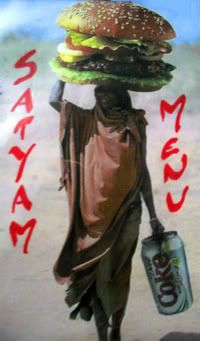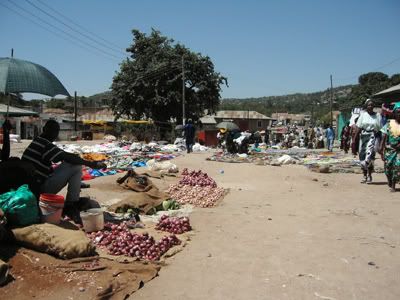A collection of journal entries of two students from the University of Western Ontario, Dallas Curow (June-August 2005) and Jonathan Birinyi (June 2005-April 2006). Feel free to read and explore their journey working on the Western Heads East probiotic yogurt nutriontal project in Mwanza, Tanzania, Africa.
FAQ #3 - So what do you eat?
Published Thursday, March 16, 2006 by G. Jonathan Birinyi | E-mail this post
Surprising to some, foods here do not include particularly exotic items. For breakfast, common foods include uji (a thin porridge from bean flour), eggs (hard boiled or in an omelet), vitumbua (a donut made from rice water), chapatti and other fried starchy items. Staple lunch and diner options include chips (often made into a french-fry omelet), rice, pilau (flavoured rice), plantains, corn (usually roasted), beans, and ugali (a stiff and thick porridge). Chicken is usually fried, but without any batter. Fish is prepared either fried or grilled, sometimes boiled. Fried fish can last about a day before eating and is often sold post-cooked in the market. Grilled fish is served with a sauce made from tomatoes, onions and other veggies called mchuzi. Meat is usually chopped into small cubes and prepared on a grill or in mchuzi. Beef and goat’s meat are the two most common types. Pork is much more uncommon because of the high Muslim population, but in this case it’s grilled with a thick sauce and referred to as “kiti moto” or hot chair.
In terms of drinks, pop is everywhere. Coke is the brand of choice; all soft drinks are sold in glass refillable bottles. There are a few juice bars around town that offer a selection of sweet choices like passion fruit, mango, sugar cane and pineapple. Tea and coffee are readily available and are quite pleasant tasting.
Beer is also popular here and several breweries exist in Tanzania. The most common brands are Tusker, Kilimanjaro, Serengeti, Castle, Safari, and Balimi – increasing in potency respectively. If you’re in a tavern though, you have to make sure you ask for cold beer, since warm beer is the preference of many in Tanzania. In regards to liquor, Konyagi is the “spirit of the nation”. I once heard a funny story from a German lady regarding the prevalence of the drink. She said, “Back when I lived here in the 80s, there were times that you couldn’t get soap, sugar or even toilet paper; but no matter what, Konyagi was always there.”
I have been a big fan of the food choices and the selection Mwanza has to offer. There are several small kitchens in and around the streets of the apartment that can fill you up for any meal. Here you can usually get the French-fry omelet as I mentioned (called “chips mayai”) or most staples with fish or chicken. Downtown and abroad, the selection becomes more diverse and includes food outside the realm of local dishes. Mwanza has a very high Indian population and hence, there are restaurants to serve their main food items. Other restaurants include places at hotels and scenic touristy locations. Their prices are consequently higher but offer foods from Thai, Chinese and Western cultures.
Like back home, the big drawback to eating out is the healthiness of the foods. Regardless of what you eat or where you go, it’s usually either high in sugar or oil or both. This is why I’ll prepare my own food in the apartment as much as possible. Veggies, fruits and fish are available in several locations around the city, whereas any meats are bought in equally frequent butcher shops. Most convenience stores usually sell foods and beverages such as pasta, canned beans, tea, coffee and a collection of other items.
If I need to get something a bit more unusual or traditional, which ever way you look at it – I’ll go to the U-turn grocery store. This is the closest thing Mwanza has to a Loblaws – and because of the monopoly, you pay through the nose for these items. The most exacerbated prices I think are in breakfast cereals, traditional Western brands reach in excess of $10 per box. Prices like this seem really high considering you can get a lot more food with less money. Such as: a small bag of peanuts, 5 cents; 5 tomatoes, 10 cents; a pineapple, 20-70 cents; bottle of pop, 25-30 cents; chips mayai, 60 cents; a serving of rice, spinach and fish, 60 cents, etc…

A menu shot from a popular Indian resturant, Satyam.

One of the mid-sized markets in Mwanza. This is the closest one to the apartment and is usually pretty decent. Forground displays some food sellers, while in the back you can see some Vitenge (skirts) on the ground being sold.

Watching a goat get slaugtered

Me eating that same goat's testicles - the only place I've seen and tried it. Circa October.
In terms of drinks, pop is everywhere. Coke is the brand of choice; all soft drinks are sold in glass refillable bottles. There are a few juice bars around town that offer a selection of sweet choices like passion fruit, mango, sugar cane and pineapple. Tea and coffee are readily available and are quite pleasant tasting.
Beer is also popular here and several breweries exist in Tanzania. The most common brands are Tusker, Kilimanjaro, Serengeti, Castle, Safari, and Balimi – increasing in potency respectively. If you’re in a tavern though, you have to make sure you ask for cold beer, since warm beer is the preference of many in Tanzania. In regards to liquor, Konyagi is the “spirit of the nation”. I once heard a funny story from a German lady regarding the prevalence of the drink. She said, “Back when I lived here in the 80s, there were times that you couldn’t get soap, sugar or even toilet paper; but no matter what, Konyagi was always there.”
I have been a big fan of the food choices and the selection Mwanza has to offer. There are several small kitchens in and around the streets of the apartment that can fill you up for any meal. Here you can usually get the French-fry omelet as I mentioned (called “chips mayai”) or most staples with fish or chicken. Downtown and abroad, the selection becomes more diverse and includes food outside the realm of local dishes. Mwanza has a very high Indian population and hence, there are restaurants to serve their main food items. Other restaurants include places at hotels and scenic touristy locations. Their prices are consequently higher but offer foods from Thai, Chinese and Western cultures.
Like back home, the big drawback to eating out is the healthiness of the foods. Regardless of what you eat or where you go, it’s usually either high in sugar or oil or both. This is why I’ll prepare my own food in the apartment as much as possible. Veggies, fruits and fish are available in several locations around the city, whereas any meats are bought in equally frequent butcher shops. Most convenience stores usually sell foods and beverages such as pasta, canned beans, tea, coffee and a collection of other items.
If I need to get something a bit more unusual or traditional, which ever way you look at it – I’ll go to the U-turn grocery store. This is the closest thing Mwanza has to a Loblaws – and because of the monopoly, you pay through the nose for these items. The most exacerbated prices I think are in breakfast cereals, traditional Western brands reach in excess of $10 per box. Prices like this seem really high considering you can get a lot more food with less money. Such as: a small bag of peanuts, 5 cents; 5 tomatoes, 10 cents; a pineapple, 20-70 cents; bottle of pop, 25-30 cents; chips mayai, 60 cents; a serving of rice, spinach and fish, 60 cents, etc…

A menu shot from a popular Indian resturant, Satyam.

One of the mid-sized markets in Mwanza. This is the closest one to the apartment and is usually pretty decent. Forground displays some food sellers, while in the back you can see some Vitenge (skirts) on the ground being sold.

Watching a goat get slaugtered

Me eating that same goat's testicles - the only place I've seen and tried it. Circa October.
0 Responses to “FAQ #3 - So what do you eat?”
Leave a Reply